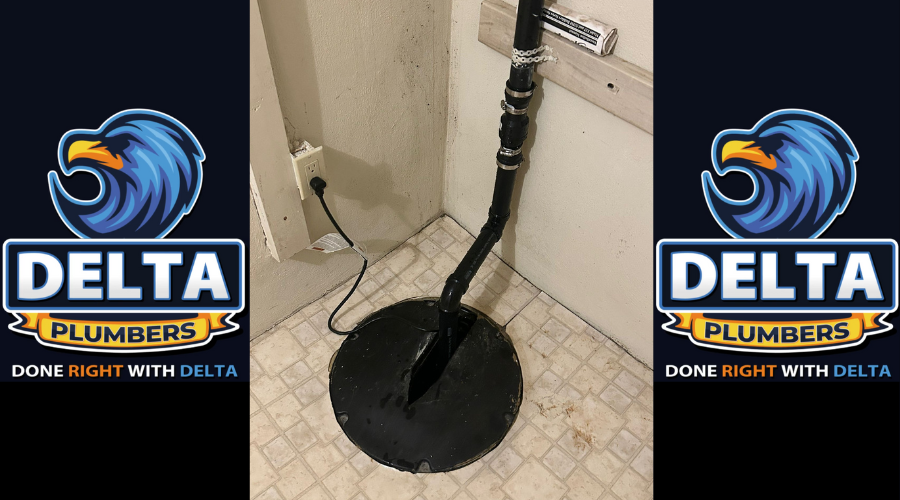Spring in Ontario can be a time of beauty and renewal, but with it comes the increased risk of heavy rainfall and snowmelt, which can quickly overwhelm basements and flood homes. The potential for basement flooding is one of the most significant concerns for homeowners in Ontario, as the spring thaw and rainstorms can trigger water seepage, foundation cracks, and sewage backups. To protect your home and belongings from the devastating effects of basement flooding, it’s essential to take proactive measures before the season begins. In this blog, we will explore in detail the key strategies to prevent basement flooding in Ontario, providing homeowners with a solid plan to safeguard their property.

Picture Source – Delta Plumbers
Inspect Your Sump Pump Regularly
A sump pump is one of the most effective tools for preventing basement flooding. It’s designed to collect excess water and pump it away from your basement, but only if it’s working properly. Many homeowners don’t realize that sump pumps require regular maintenance to operate effectively. A failed sump pump can leave your basement vulnerable to flooding, especially during heavy rainstorms or snowmelt when groundwater levels rise.
Steps to inspect your sump pump:
- Test the pump: You can test your sump pump by pouring water into the sump pit. The pump should turn on automatically, expel the water, and stop when the pit is empty. If the pump doesn’t start, there could be an issue with the power supply, the float switch, or a clog in the system.
- Clean the pump: Over time, dirt and debris can accumulate in the pump’s basin and impeller. Be sure to clean the sump pit regularly to remove these blockages. A clean pump will operate more efficiently and is less likely to malfunction.
- Check the discharge pipe: Ensure the discharge pipe is free of any obstructions and directs water well away from the foundation. The water should not be redirected toward the house, as that could lead to water pooling near your basement walls.
- Consider a backup pump: For extra protection, consider installing a battery-powered or water-powered backup sump pump. This will ensure that your basement remains dry even if the power goes out during a storm.
Regular sump pump maintenance is crucial for preventing basement flooding and will provide you with peace of mind, knowing that your home is prepared for spring rains.
Also Read: Top 5 Plumbing Issues in Older Homes (and How to Address Them)

Picture Source – Delta Plumbers
Ensure Proper Drainage Around Your Home
Proper drainage around your home is perhaps the most important aspect of preventing basement flooding. Water naturally flows downhill, and if the ground around your house slopes toward the foundation, it can lead to water pooling near your basement walls and seeping into the basement. Ensuring proper drainage will help direct rainwater and melting snow away from your foundation.
Key actions to improve drainage:
- Clean your gutters and downspouts: Blocked gutters and downspouts can prevent rainwater from being directed away from your house. Leaves, twigs, and dirt can build up in gutters, causing them to overflow and spill water directly onto the ground next to your foundation. Make sure to clean your gutters in the fall and again in the spring before heavy rains begin.
- Extend downspouts away from the foundation: Your downspouts should extend at least 3 to 4 feet away from the house to prevent water from flowing back toward the foundation. Use downspout extensions or splash blocks to help direct the water away from your basement walls.
- Grade the soil around your home: The ground should slope away from your home at a 1-inch drop for every foot of distance. This ensures that rainwater runs off instead of collecting near the foundation. You may need to regrade your yard by adding soil to low spots and making sure the slope is consistent around the perimeter of your house.
- Install French drains or drainage channels: For homes with persistent drainage issues, installing a French drain system can help direct excess water away from the foundation. A French drain consists of a trench filled with gravel and a perforated pipe that allows water to flow away from the house. Drainage channels can also be installed in areas where water tends to pool.
By improving the drainage around your home, you can effectively reduce the chances of basement flooding during heavy spring rains.
Also Read: How to Detect and Fix Hidden Water Leaks in Your Home

Picture Source – Delta Plumbers
Seal Cracks and Gaps in Your Foundation
Even small cracks and gaps in your foundation can allow water to seep into your basement, especially when combined with heavy rainfall or snowmelt. Water can enter your basement through these cracks, causing significant damage over time. It’s important to regularly inspect your foundation for visible cracks and seal them promptly to prevent water infiltration.
How to seal cracks:
- Inspect the foundation: Check your foundation both inside and outside for cracks, gaps, or signs of water infiltration. Look for cracks around windows, doors, and in corners, as these are common entry points for water. Pay attention to any damp spots or puddles inside your basement, which could indicate a problem.
- Use hydraulic cement: For small hairline cracks, you can use hydraulic cement to fill and seal the cracks. Hydraulic cement expands as it cures, creating a tight seal that is resistant to water penetration.
- Apply waterproof sealant: Waterproofing sealants can be applied to both the interior and exterior of your foundation. These sealants create a barrier that prevents water from passing through the walls. Be sure to follow the manufacturer’s instructions for proper application.
- Professional sealing: For larger cracks or more serious foundation issues, it’s recommended to hire a professional contractor who can apply epoxy or polyurethane injections. These materials are designed to fill and seal cracks, ensuring a watertight foundation.
Sealing cracks in your foundation is an affordable and effective way to prevent basement flooding and protect your home from water damage.
Also Read: Tankless Water Heater: Why You Should Upgrade

Picture Source – Delta Plumbers
Install a Backflow Valve
During heavy rainfall or snowmelt, the local sewer system in Ontario can become overwhelmed, which can lead to sewage backups into basements. To prevent this from happening, installing a backflow valve is one of the most effective solutions. This device prevents water from flowing back into your basement’s plumbing system, keeping wastewater from entering your home.
Why install a backflow valve?
- Prevents sewage backups: A backflow valve allows wastewater to flow out of your home, but it prevents any water from flowing back in. This is especially important if you have a basement bathroom, laundry room, or kitchen sink that is connected to the sewer line.
- Easy installation: A backflow valve can be installed relatively easily by a licensed plumber and is an affordable addition to your home’s plumbing system. It can be added to your main sewer line or the basement’s floor drain.
- Provides peace of mind: If you live in an area with frequent heavy rain or storms, a backflow valve offers added security, ensuring that your basement remains dry even if the local sewer system becomes flooded.
Installing a backflow valve is a smart investment to prevent basement flooding caused by sewer backups.
Also Read: Routine Drain Cleaning: Why it is Essential for Your Home.

Picture Source – Delta Plumbers
Maintain Your Foundation’s Waterproofing System
Waterproofing is a long-term solution for protecting your basement from flooding. A properly waterproofed foundation creates a barrier that prevents water from seeping into your basement through the walls or floor. If your home’s waterproofing system is outdated or damaged, it may fail to provide adequate protection during a heavy rainstorm.
Tips for maintaining waterproofing:
- Inspect exterior waterproofing: If your home was waterproofed when it was built, it’s essential to check the exterior walls for any signs of wear or damage. Look for peeling paint, cracks, or visible mold, which can indicate that the waterproofing layer is compromised.
- Reapply waterproof sealants: Over time, the sealants used to waterproof your foundation can wear down. Reapplying a waterproof sealant every few years is a cost-effective way to keep your basement protected.
- Install or maintain a French drain: A French drain is a trench filled with gravel and a perforated pipe that helps direct water away from your foundation. If your home does not have one, consider installing one around the exterior perimeter of your basement to ensure proper water drainage.
- Waterproof the interior: In addition to exterior waterproofing, consider installing an interior drainage system and vapor barrier to provide added protection against moisture.
Regularly maintaining your foundation’s waterproofing system will ensure that your basement stays dry and safe from spring flooding.
Also Read: Top Plumbing Problems in Commercial Buildings and How to Solve Them

Picture Source – Delta Plumbers
Keep Landscaping Away from Your Foundation
Your landscaping can play a significant role in preventing basement flooding. Plants, mulch, and garden beds placed too close to the foundation can obstruct water flow, allowing moisture to accumulate near your basement walls.
Landscaping tips:
- Maintain a 12-inch gap: Ensure that plants and garden beds are at least 12 inches away from the foundation. This allows water to flow freely around the house without being diverted toward the foundation.
- Use hardscaping elements: Consider replacing some soft landscaping elements with hardscaping materials like gravel, stones, or pavers. These materials allow water to permeate and flow away from the house, reducing the risk of pooling.
- Prune trees and bushes: Overgrown trees and shrubs can obstruct downspouts and create areas where water can accumulate. Regular pruning will help maintain proper drainage.
Proper landscaping helps keep water away from your foundation and reduces the chances of basement flooding.
Also Read: Best Plumbing Services in Ontario: What to Look For

Picture Source – Delta Plumbers
Consider a Basement Flooding Insurance Policy
Even with all the preventive measures in place, it’s impossible to guarantee that your basement will never flood. Spring rains and snowmelt can be unpredictable, and unexpected issues like clogged drains or sewer backups can occur. Having a basement flooding insurance policy in place will provide financial protection in case the worst happens.
Why you should consider flood insurance:
- Covers damages caused by water infiltration: Flood insurance will cover the cost of repairing structural damage caused by water entering your basement. It also covers the replacement of damaged personal belongings and the removal of mold.
- Peace of mind: Flood insurance gives you peace of mind, knowing it will protect you financially if your basement floods.
- Customizable coverage: You can tailor flood insurance policies to meet your needs and address your specific risk factors.
Although insurance cannot prevent flooding, it provides invaluable protection for your home and belongings.
Conclusion –
Preventing basement flooding in Ontario this spring requires a proactive approach that includes inspecting your sump pump, improving drainage around your home, sealing foundation cracks, installing backflow valves, and maintaining your waterproofing system. In addition to these preventive measures, keeping landscaping away from your foundation and considering flood insurance will provide extra protection against water damage. By taking these steps now, you’ll ensure that your basement remains dry and safe throughout the rainy spring season.









